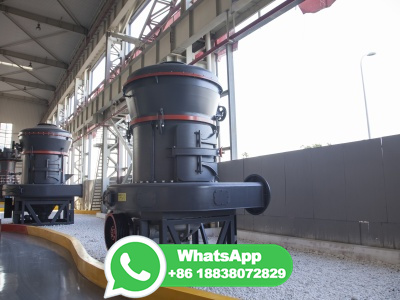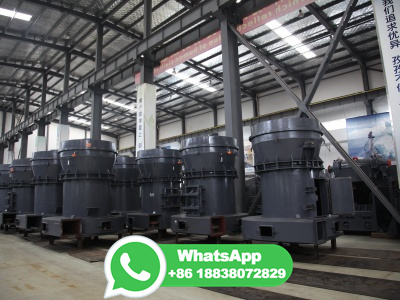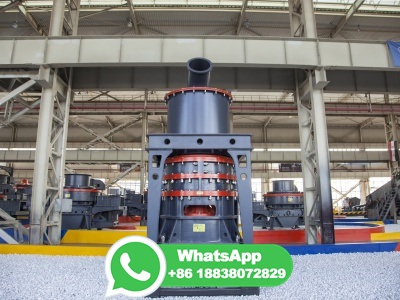
Coal rank is certainly one of the features as shown by the difference between WVGS 13421, which is a mediumvolatile bituminous coal, and the lower rank WVGS 13423, which is a highvolatile A bituminous coal. In very broad terms, hydrogenation activity in terms of hydrogen utilization increases as coal rank decreases.
WhatsApp: +86 18838072829
The Process Intensification for Syngas Hydrogen key technology area addresses control of chemical reactions in increasingly modular and intrinsically efficient reactors, allowing for streamlined processes with wellcoordinated unit operations, and with a focus on gasification of biomass and carbonaceous wastes into syngas, syngas cleanup, efficient hydrogen and carbon dioxide separation, and ...
WhatsApp: +86 18838072829
Replacing the cryogenic process currently used to separate oxygen from air when oxygen is used in the gasifier with new membrane technology. Developing new membrane technologies to better separate and purify hydrogen from the gas stream produced (similar to coal gasification). Intensifying the process (combining steps into fewer operations).
WhatsApp: +86 18838072829
Midilli et al. [19] reviewed and evaluated hydrogen production methods through the coal gasi cation process, and the results indicated that the gasi cation system generates more hydrogen and is ...
WhatsApp: +86 18838072829
Hydrogen production from electrolyzed coal slurry is superior to the traditional electrolysis water process in terms of energy consumption and production efficiency. This technology can simultaneously achieve the purification of the ore during the electrolysis process, which is worthy of promotion and development.
WhatsApp: +86 18838072829
Generating hydrogen can be carbon intensive, however, and the process of compressing, cooling, and liquifying it is energyintensive. For hydrogen use in different applications to be carbon free, it must be produced through a lowcarbon process. Hydrogen Production The global demand for hydrogen was about 70 million metric tons (Mt)3 per year ...
WhatsApp: +86 18838072829
Coal gasification is defined as the thermochemical conversion process in which coal is converted into gaseous products, including hydrogen and carbon monoxide. (49−51) This process aims to be an alternative to burning coal to reduce harmful emissions and increase the energy density of the fuel.
WhatsApp: +86 18838072829
A synthesis gas can also be created by reacting coal or biomass with hightemperature steam and oxygen in a pressurized gasifier. This converts the coal or biomass into gaseous components—a process called gasification. The resulting synthesis gas contains hydrogen and carbon monoxide, which is reacted with steam to separate the hydrogen.
WhatsApp: +86 18838072829
1. China alone has 1/3 of world ammonia production capacity, demanding large amounts of hydrogen production capacity. 2. In 2005 and 2008, when Henry Hub natural gas prices were often above 7/MMBtu and peaking in the 1015 range, SNG had a price advantage over natural gas, as evidenced by the interest at that time of developing new SNG plants (SNG cost is estimated at ~7/MMBtu).
WhatsApp: +86 18838072829
Hydrogen can be used in steel and aluminum production — where its chemical reactivity also helps reduce ore into more useable forms — instead of the currently used coking coal or natural gas. In these industrial processes, hydrogen will be consumed directly as a chemical feedstock in the production process or burned to provide the necessary ...
WhatsApp: +86 18838072829
To produce hydrogen from coal, the process begins with partial oxidation, which means some air is added to the coal, which generates carbon dioxide gas through traditional combustion. Not...
WhatsApp: +86 18838072829
Cannel coal (sometimes called "candle coal") is a variety of finegrained, highrank coal with significant hydrogen content. It consists primarily of "exinite" macerals, now termed "liptinite." ... (CO), while also releasing hydrogen gas (H 2). This process has been conducted in both underground coal mines and in the production of ...
WhatsApp: +86 18838072829
According to the International Energy Agency, 96% of hydrogen produced worldwide is made using fossil fuels coal, oil and natural gas in a process known as reforming. This involves ...
WhatsApp: +86 18838072829
A typical hydrogen demand is ~80 kg [citation needed] hydrogen per ton of dry, ashfree coal. Generally, this process is similar to hydrogenation. The output is at three levels: heavy oil, middle oil, gasoline. The middle oil is hydrogenated in order to get more gasoline and the heavy oil is mixed with the coal again and the process restarts.
WhatsApp: +86 18838072829
The combined process of biomass pyrolysis and inline catalytic steam reforming is a promising alternative for the selective production of hydrogen from renewable sources. In this Primer, Lopez et ...
WhatsApp: +86 18838072829
Mitsubishi Power's development of a 1,650Cclass multicluster combustor is underway. Combustion tests are slated in 2025, and the company is eyeing commercialization by 2030, "when hydrogen ...
WhatsApp: +86 18838072829
SteamMethane Reforming. Most hydrogen produced today in the United States is made via steammethane reforming, a mature production process in which hightemperature steam (700°C1,000°C) is used to produce hydrogen from a methane source, such as natural gas. In steammethane reforming, methane reacts with steam under 325 bar pressure (1 ...
WhatsApp: +86 18838072829
In traditional steelmaking, this is done using coal or natural gas in a process that releases CO₂. In green steel production, hydrogen made from renewable energy replaces fossil fuels.
WhatsApp: +86 18838072829
A comparison of production process for the "blue" and "green" types of hydrogen. (Supplied: ... The government has partly funded a trial to produce "blue hydrogen" from coal in Victoria's Latrobe ...
WhatsApp: +86 18838072829
The lower carbon to hydrogen ratio in coal relative to natural gas results in significantly higher direct CO 2 emissions from the process. The inventory data for both coal gasification routes (without and with CCS) are taken from the works by Ruthowski and Vickers, respectively [37], [38]. (4) C + 2 H 2 O ↔ CO 2 + 2 H 2.
WhatsApp: +86 18838072829
The notable products in a coal pyrolysis process encompass CO, H 2, CH 4, ... Life cycle energy consumption and GHG emissions of biomasstohydrogen process in comparison with coaltohydrogen process. Energy, 191 (2020), Article 116588. View PDF View article View in Scopus Google Scholar [43]
WhatsApp: +86 18838072829
The FischerTropsch process (FT) is a collection of chemical reactions that converts a mixture of carbon monoxide and hydrogen, known as syngas, into liquid reactions occur in the presence of metal catalysts, typically at temperatures of 150300 °C (302572 °F) and pressures of one to several tens of FischerTropsch process is an important reaction ...
WhatsApp: +86 18838072829
Black, brown and grey hydrogen. Grey hydrogen is the most common form and is generated from natural gas, or methane, through a process called "steam reforming". This process generates just a smaller amount of emissions than black or brown hydrogen, which uses black (bituminous) or brown (lignite) coal in the hydrogenmaking process.
WhatsApp: +86 18838072829
To produce hydrogen from coal, the process begins with partial oxidation, which means some air is added to the coal, which generates carbon dioxide gas through traditional combustion. Not enough is added, though, to completely burn the coal only enough to make some heat for the gasification reaction.
WhatsApp: +86 18838072829
Traditional coaltoliquid processes use gasification with excess steam to obtain hydrogenrich syngas for downstream manufacturing of methanol or FischerTropsch liquids. Such processes are shown to produce very large amounts of CO2 directly by the WaterGasShift (WGS) reaction or, indirectly, by combustion in raising steam. It is shown how any coal gasifier can operate under autothermal ...
WhatsApp: +86 18838072829
In the process of coal mine excavation with abnormal hydrogen sulfide, the hydrogen sulfide enriched in the coal stratum will rush out (escape) into the roadway or mining face, a large amount of hydrogen sulfide escapes during the crushing process, hydrogen sulfide is often emitted from the upper corners and goafs, and a large amount of ...
WhatsApp: +86 18838072829
Electrolysis is a process that splits hydrogen from water using an electric current. Electrolysis is commonly used in high school science classes to demonstrate chemical reactions and hydrogen production. On a large, commercial scale, the process may be referred to as powertogas, where power is electricity and hydrogen is gas. Electrolysis ...
WhatsApp: +86 18838072829
The process happens in the absence of air and oxygen, and consequently, the formation of dioxins can be ruled out. The absence of air or water means there will be no formation of carbon oxides (CO 2 and CO) to require secondary reactors. As a result, this process of hydrogen production helps to reduce emissions.
WhatsApp: +86 18838072829
Black and brown hydrogen. Using black coal or lignite (brown coal) in the hydrogenmaking process, these black and brown hydrogen are the absolute opposite of green hydrogen in the hydrogen spectrum and the most environmentally damaging. Just to confuse things, any hydrogen made from fossil fuels through the process of 'gasification' is ...
WhatsApp: +86 18838072829
In the traditional process of hydrogen production from coal, coal is gasified to syngas in an entrained gasifier. After heat recovery, the syngas is cooled and then shifted to mainly CO2 and H2. Following a separation step, in which H2S and CO2 is removed by Selexol process, high purity H2 (%) is produced via pressure swing adsorption (PSA).
WhatsApp: +86 18838072829
There are many studies on hydrogenbased production on coal gasification and the multigenerative system based on coal ... Ni, Rh and the outside is made of aluminum electrode. Several feed gases could be used to carry out the plasmolysis process. Hydrogen can be produced by using various feedstock such as water or its vapors and ...
WhatsApp: +86 18838072829
Library. Reactions Transformations. The chemistry of gasification is quite complex and is accomplished through a series of physical transformations and chemical reactions within the gasifier. Some of the major chemical reactions are shown in the diagram below. In a gasifier, the carbonaceous feedstock undergoes several different ...
WhatsApp: +86 18838072829
The methane sticks to the surface of the coal, in a process called adsorption. ... an energy source that involves a process for making hydrogen by using methane in natural gas is being lauded ...
WhatsApp: +86 18838072829